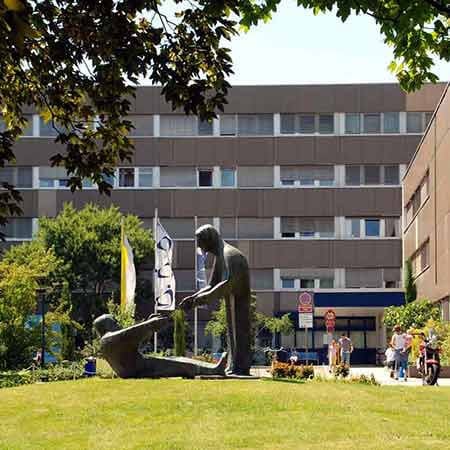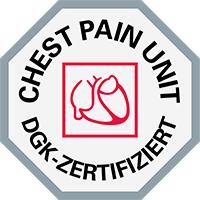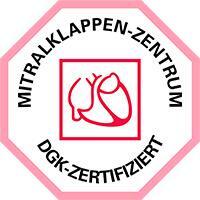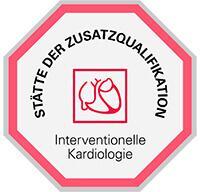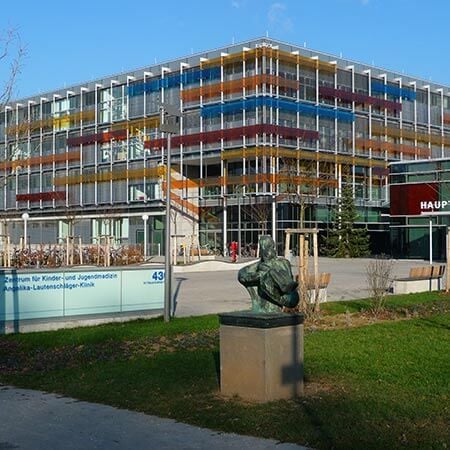Ventricular flutter and fibrillation is a rapid rhythmic movement of the ventricles caused by systematic circular impulses. Typically, ventricular flutter turns into ventricular fibrillation later in progression. Ventricular fibrillation of the heart is a rapid disorderly excitation, during which the fibers of the ventricular muscles contract.
Content
- About tachycardia
- Ventricular flutter overview
- What causes ventricular flutter?
- Symptoms of ventricular flutter
- Stages of VF
- How is ventricular flutter treated in Europe?
- Can ventricular flutter be prevented?
- The cost of treatment in European hospitals
- Why use the services of Booking Health?
About tachycardia
Tachycardia (or flutter) is classified primarily by the source of the acceleration of the heartbeat. Different parts of the heart can form an electrical impulse. Normally, it is the sinus node, from which the excitation is transmitted to the myocardium. With such cardiac pathologies, the electrical impulse is formed in the nerve cells, which are located in the atria, ventricles, etc. Accordingly, the palpitations may be sinus, atrial, ventricular, or atrioventricular. If the attack suddenly begins and also ends, the condition is called paroxysmal.
Atrial variety of tachycardia (atrial fibrillation) is detected somewhat less often. It occurs in a small area, appears irregularly, but can last for several days or even months. Patients with severe heart failure, the elderly in particular, may have a severe course of atrial fibrillation, but most often the condition is not dangerous, proceeds asymptomatically, or with weak manifestations. These may be dizziness, shortness of breath, or pain in the chest area. This condition is treated with standard medications like quinidine and other depressants, antiarrhythmic drugs, and anesthetics. In complicated cases, surgical catheter ablation is performed.
Among the types of tachycardia related to disorders of the proper functioning of the heart, there are supraventricular and ventricular tachycardias. The first is characterized by abnormalities of heart rhythm at the atrial level. It can be an independent disease caused due to the consequences of other cardiac diseases or abnormalities in the structure of the heart.
The ventricular type of flutter is divided into two varieties: nodal and with additional conduction pathways. Tachycardia is quite common (especially in women), with its attacks being rare, occurring suddenly, and lasting from a few minutes to a day or more. Among the symptoms, the following are noted:
- Pulsation in the cervical area is characteristic for a tachycardia attack.
- Decreased blood pressure.
- Angina pains.
- Episodes of choking and loss of consciousness.
Ventricular flutter overview
Ventricular flutter implies a fast heart rhythm (more than 100 per minute) that can lead to cardiac arrest.
The ventricular structure of the heart is responsible for the release of blood into the aorta, providing adequate blood flow and blood pressure levels. During an attack of ventricular flutter, the blood supply to vital organs is disrupted, which can lead to fainting, low blood pressure, and sudden cardiac death.
Ventricular flutter can occur in patients with a structurally normal heart, but usually occurs against the background of other heart diseases, including congenital heart diseases. Therefore, the treatment is aimed primarily at the therapy of the underlying disease and the prevention of attacks. Drug therapy gives a temporary effect, so in most cases, radiofrequency (catheter) ablation is recommended. If the development of ventricular tachycardia is accompanied by structural myocardial pathology or hereditary channelopathies, implantation of a cardioverter-defibrillator is indicated.
On the other hand, ventricular fibrillation is an emergency condition that requires immediate medical attention. A person with ventricular fibrillation will lose consciousness and fall within seconds, then lose their breathing and pulse. The emergency treatment for ventricular fibrillation consists of cardiopulmonary resuscitation and electrical shocks to the heart with a defibrillator.
Ventricular heart rhythm disturbances (VHD) and, first of all, ventricular tachycardias, most often associated with CHD and its complications or hereditary genetic pathology, appear to be the most important risk factors for sudden cardiac death. Thus, ventricular fibrillation is the cause of cardiac death in developed countries in 75-80% of patients with cardiac pathologies, and other arrhythmias play a much smaller role in its development. At the same time, in several cases, patients without organic heart damage and genetic diseases (long QT syndrome, Brugada syndrome, arrhythmogenic right ventricular cardiomyopathy, etc.) probably do not have a significant negative impact on the statistics for life expectancy.
What causes ventricular flutter?
Ventricular flutter is most often caused by another heart disease or other rather severe pathologies. A list of diseases and other factors that can provoke ventricular flutter and, subsequently, fibrillation include:
- Ischemia (pathology appearing due to poor blood circulation and insufficient oxygen supply to the heart).
- Myocardial infarction (the result of poor blood flow to the heart and cardiac tissue death).
- Myocarditis (inflammatory process in the very muscles of the heart caused by infection).
- Hypertension (constant high blood pressure).
- Heart defects (deformation of the heart structure).
- Cardiomyopathic disease (disruption of normal functioning due to deformation of the heart muscles).
- Drug poisoning and its side effects.
- Hypoxic disease (caused by poor oxygen supply to the body cells).
Symptoms of ventricular flutter
The manifestations of ventricular flutter and fibrillation correspond to the picture of clinical death. In ventricular flutter, low cardiac output and arterial hypotension may persist for a short time. Ventricular flutter rarely ends with the spontaneous recovery of sinus rhythm. More commonly, the erratic rhythm progresses to ventricular fibrillation.
Ventricular flutter and fibrillation are accompanied by circulatory arrest, loss of consciousness, the disappearance of pulse on carotid and femoral arteries, agonal breathing, sharp pallor, or diffuse cyanosis of the skin. In the episode, the pupils are dilated and their reaction to light is absent. Tonic convulsions, involuntary urination, and defecation may occur. If within the next 4 or 5 minutes an effective heart rhythm is not restored, irreversible changes in the CNS and other organs occur.
The worst outcome of ventricular flutter and fibrillation is death. The complications associated with cardiopulmonary resuscitation may be aspiration pneumonia, lung injury with a rib fracture, pneumothorax, and hemothorax. In the post-resuscitation period, the patient can often develop various ventricular arrhythmias, anoxic (hypoxic, ischemic) encephalopathy, and myocardial dysfunction due to reperfusion syndrome.
Stages of VF
Paroxysms of ventricular flutter and fibrillation have 4 stages in their development.
The first stage implies the actual ventricular flutter. It lasts 1-2 seconds and is characterized by frequent, coordinated heartbeats, which corresponds to ventricular complexes with sharp high-amplitude oscillations on ECG.
The second one is called the convulsive stage. It lasts from 15 to 50 seconds. At this time, frequent, irregular local myocardial contractions are noted. The electrocardiographic picture is characterized by high-voltage waves of different magnitude.
The third ventricular fibrillation stage lasts from 2 to 3 minutes and is accompanied by many irregular contractions of separate sections of the myocardium of different frequencies.
The fourth stage is atony (the loss of muscle strength). It develops 2-5 minutes after the beginning of ventricular fibrillation. It is characterized by small, irregular waves of contractions, and an increase in the number of non-contraction areas. On ECG, irregular waves with gradually decreasing amplitude are registered.
According to the variant of the clinical course, paroxysmal and permanent forms of ventricular flutter and fibrillation are distinguished. Paroxysms in flutter or fibrillation may be recurrent or repeated several times a day.
How is ventricular flutter treated in Europe?
The treatment of ventricular flutter and fibrillation should be started very quickly, as the conditions can be fatal in a fairly short time if the necessary measures are not taken.
If the condition has progressed into fibrillation, and the patient did lose consciousness outside the hospital setting, indirect heart massage and CPR should be performed while waiting for an ambulance. When doctors arrive, the patient will immediately be brought out of ventricular fibrillation with the help of a defibrillator. The patient will be connected to a ventilator. Doctors will make an intravenous injection of adrenaline in order to stimulate the heart, as well as give antiarrhythmic drugs to help normalize the heart rhythm.
Complications and consequences that can occur in a person after ventricular flutter and fibrillation may include:
- Aspiration inflammation of the lungs.
- Injuries sustained during a person's fainting fall or when the heart is started by a violent blow to the chest with a fist or the rib of the hand.
- Heart failure, clogged blood vessels, poor circulation due to blood clots, especially in the arms and legs.
The treatment of patients at risk of developing atrial fibrillation consists of taking medications and implantation of devices capable of restoring normal heart rhythm.
The treatment of flutter and ventricular fibrillation includes emergency and planned therapy. Emergency care consists of rapid restoration of heart rhythm by the means of indirect cardiac massage, artificial respiration, defibrillation, and drug therapy. Planned therapy for ventricular flutter and fibrillation is aimed at preventing the development of this condition and can be conservative and operative.
The conservative method is aimed at the treatment of the underlying disease and the prevention of ventricular flutter and fibrillation. It includes the prescription of antiarrhythmic drugs and lifestyle changes. Surgical treatment consists of the implantation of either a cardioverter-defibrillator or a dual-chamber pacemaker.
The cardiology departments of European hospitals perform the full range of diagnostic and therapeutic services, as well as use the most advanced regimens and methods of treatment for various cardiovascular diseases. Doctors choose treatment methods on an individual basis, taking into account the stage and type of pathology, the presence of risk factors, and concomitant diseases.
Timely diagnosis and treatment of diseases that are the causes of the development of ventricular flutter and fibrillation are vital, among which the most common are:
- Myocardial infarction. It is treated by taking thrombolytics (drugs that break up blood clots), anticoagulants (drugs that prevent the formation of blood clots), and beta-blockers (drugs that reduce blood pressure).
- Hypertension. It is treated by taking hypotensive drugs of central action (drugs that act on the structures of the brain, thereby reducing blood pressure), beta-blockers, diuretics (drugs that remove fluid from the body), etc.
- Myocarditis. It is treated by taking antibiotics (drugs that kill microorganisms).
Doctors working in European hospitals can achieve the maximum results of treatment applying a comprehensive approach, while their vast practical experience and high professionalism allow them to perform surgical interventions of any complexity, including those applying endoscopic equipment.
If therapy with medication for the treatment of ventricular flutter does not give positive results, it is necessary to evaluate the possibilities of non-drug methods of treatment.
Radiofrequency catheter destruction is the most effective among those for some types of idiopathic disease. According to American research, the effectiveness of RCD in such patients exceeds 85%. In patients with postinfarction cardiosclerosis and dilated cardiomyopathy, the number of positive results is significantly less (about 50 %), and therefore RCD in patients is more often used as an addition to cardioverter-defibrillator implantation for the reduction of frequency of VF paroxysms.
The surgical treatment of VF is primarily indicated in patients with segmental myocardial damage (postinfarction scar, aneurysm) and preserved left ventricular contractile function. With congestive heart failure and/or low ejection fraction, which is common for the majority of patients with ventricular flutter, the results of surgical intervention (aneurysmectomy, endocardial ventriculotomy, subendocardial resection) are much worse. Therefore, surgical treatment of ventricular flutter in Europe is currently used relatively rarely, and in cases requiring it, the preference is given to cardioverter-defibrillator implantation performed without thoracotomy.
Can ventricular flutter be prevented?
To prevent the development of ventricular flutter and fibrillation, it is necessary to follow general principles. These include:
- Taking medications at the amount and frequency as prescribed by your doctor (if you have already been diagnosed with another heart condition).
- Eliminating alcohol intake.
- Following a balanced and nutrient-dense diet (priority should be given to vegetables and plant-based products; avoiding fatty, spicy, and smoked dishes).
- Refusing from excessive physical activity.
- Eliminating mental and emotional stress.
The cost of treatment in European hospitals
Many patients with ventricular flutter are hesitant to go to Europe for medical treatment because they mistakenly consider the cost of treatment unaffordable. However, the cost of treatment and prices for most medical procedures for ventricular flutter in European hospitals is quite acceptable even for people with average income. This is possible due to the state’s implementation of special programs and treatment protocols, as well as constant state control of prices in both private and public medical facilities. In addition, the patient undergoes only necessary procedures for making an accurate diagnosis, which saves a lot of money. Summing up, we can also note that prices in Europe for the same medical services do not differ significantly from the other places known for high-quality treatment.
If you need any help figuring out what the cost of treatment in your clinical case will be, Booking Health is happy to assist you.
Why use the services of Booking Health?
You can undoubtedly organize the whole treatment in Europe yourself. However, it is quite difficult to do so. Most medicine-orientated web pages that you potentially come across do not highlight the full picture of treatment arrangement, and as result, unexpected issues are likely to arise. Besides, it can be difficult for a person who has just started to get an idea of how the whole thing of treatment abroad works to differentiate the valid info from marketing.
With Booking Health, however, you are fully supported with each step of your treatment journey. Booking Health works by the principle of transparency first and foremost, so whatever questions you have, we will answer them with complete honesty.
Please, do feel free to contact Booking Health for any information you need by using the request form on the website.
Authors: Dr. Vadim Zhiliuk, Dr. Sergey Pashchenko
